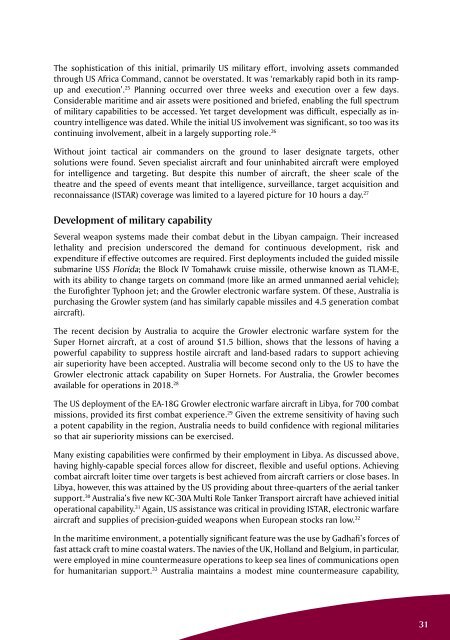ISSUE 191 : Jul/Aug - 2013 - Australian Defence Force Journal
ISSUE 191 : Jul/Aug - 2013 - Australian Defence Force Journal
ISSUE 191 : Jul/Aug - 2013 - Australian Defence Force Journal
- No tags were found...
You also want an ePaper? Increase the reach of your titles
YUMPU automatically turns print PDFs into web optimized ePapers that Google loves.
The sophistication of this initial, primarily US military effort, involving assets commanded<br />
through US Africa Command, cannot be overstated. It was ‘remarkably rapid both in its rampup<br />
and execution’. 25 Planning occurred over three weeks and execution over a few days.<br />
Considerable maritime and air assets were positioned and briefed, enabling the full spectrum<br />
of military capabilities to be accessed. Yet target development was difficult, especially as incountry<br />
intelligence was dated. While the initial US involvement was significant, so too was its<br />
continuing involvement, albeit in a largely supporting role. 26<br />
Without joint tactical air commanders on the ground to laser designate targets, other<br />
solutions were found. Seven specialist aircraft and four uninhabited aircraft were employed<br />
for intelligence and targeting. But despite this number of aircraft, the sheer scale of the<br />
theatre and the speed of events meant that intelligence, surveillance, target acquisition and<br />
reconnaissance (ISTAR) coverage was limited to a layered picture for 10 hours a day. 27<br />
Development of military capability<br />
Several weapon systems made their combat debut in the Libyan campaign. Their increased<br />
lethality and precision underscored the demand for continuous development, risk and<br />
expenditure if effective outcomes are required. First deployments included the guided missile<br />
submarine USS Florida; the Block IV Tomahawk cruise missile, otherwise known as TLAM-E,<br />
with its ability to change targets on command (more like an armed unmanned aerial vehicle);<br />
the Eurofighter Typhoon jet; and the Growler electronic warfare system. Of these, Australia is<br />
purchasing the Growler system (and has similarly capable missiles and 4.5 generation combat<br />
aircraft).<br />
The recent decision by Australia to acquire the Growler electronic warfare system for the<br />
Super Hornet aircraft, at a cost of around $1.5 billion, shows that the lessons of having a<br />
powerful capability to suppress hostile aircraft and land-based radars to support achieving<br />
air superiority have been accepted. Australia will become second only to the US to have the<br />
Growler electronic attack capability on Super Hornets. For Australia, the Growler becomes<br />
available for operations in 2018. 28<br />
The US deployment of the EA-18G Growler electronic warfare aircraft in Libya, for 700 combat<br />
missions, provided its first combat experience. 29 Given the extreme sensitivity of having such<br />
a potent capability in the region, Australia needs to build confidence with regional militaries<br />
so that air superiority missions can be exercised.<br />
Many existing capabilities were confirmed by their employment in Libya. As discussed above,<br />
having highly-capable special forces allow for discreet, flexible and useful options. Achieving<br />
combat aircraft loiter time over targets is best achieved from aircraft carriers or close bases. In<br />
Libya, however, this was attained by the US providing about three-quarters of the aerial tanker<br />
support. 30 Australia’s five new KC-30A Multi Role Tanker Transport aircraft have achieved initial<br />
operational capability. 31 Again, US assistance was critical in providing ISTAR, electronic warfare<br />
aircraft and supplies of precision-guided weapons when European stocks ran low. 32<br />
In the maritime environment, a potentially significant feature was the use by Gadhafi’s forces of<br />
fast attack craft to mine coastal waters. The navies of the UK, Holland and Belgium, in particular,<br />
were employed in mine countermeasure operations to keep sea lines of communications open<br />
for humanitarian support. 33 Australia maintains a modest mine countermeasure capability,<br />
31

















